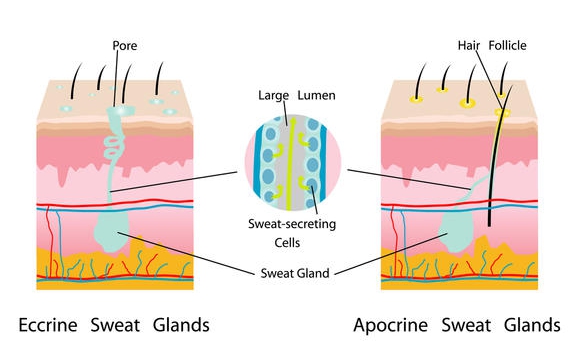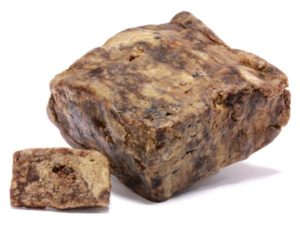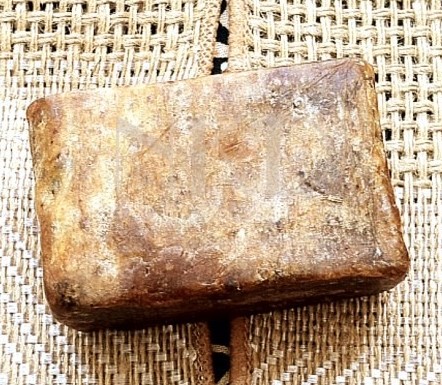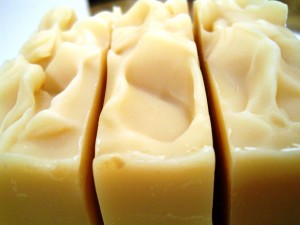Naokeidoe Creations
Handcrafted Soap, Bath & Body, Hair Care, Home Goods and Style
-
Sweating, Body Odor and Apocrine Glands
Sweat is essential to human survival and serves as the body’s coolant, protecting it from overheating.
There are two to four million sweat glands distributed all over our bodies.
You skin has two main types of sweat glands; Eccrine and Apocrine.
Eccrine sweat glands are far more numerous and occur on virtually all skin surfaces. Sweating on your forehead, back, arms, etc. They become functional shortly after birth and produce a clear, watery, odorless substance in relatively large amounts to cool the body when overheated.
Apocrine sweat glands, larger than eccrine glannds, occur only in the armpits and pubic area, and around the nipples and navel. They do not become active until puberty and secrete small amounts of a milky, thick substance that is rich in fats.
Although apocrine sweat is odorless when secreted, bacteria normally found on the skin comes in contact with the fats. When this fatty fluid comes in contact with bacteria on the skin’s surface, it produces a characteristic body odor. This is the primary source of body odor arising from both the pubic region and the armpits.
Both the eccrine and apocrine sweat glands are activated by nerves. These nerves respond to a variety of stimuli including:
- - messages from the brain indicating that the body is too hot
- - hormones
- - emotions
- - physical activity or exercise.
In people who have excessive sweating, or hyperhidrosis, the sweat glands (eccrine glands in particular) overreact and are overactive to stimuli, producing more sweat than is necessary.
 Eccrine and Apocrine Glands - How They Work And How Odor Is Created
Eccrine and Apocrine Glands - How They Work And How Odor Is CreatedThe presence of pubic hair in the genital region contributes to body odor emanating from this area for several reasons. While eccrine glands discharge their watery secretions directly onto the skin surface, apocrine glands empty into hair follicles -- as do skin oil glands. The combination of apocrine sweat and skin oil, or sebum, sticks to pubic hairs. Bacteria that feed on these substances also adhere to pubic hairs. Thus, pubic hair provides a physical environment that supports the processes that lead to body odor. The same holds true for armpit hair. People who shave their armpits generally exude less body odor. Similarly, people who trim or remove their pubic hair also usually have less body odor in their pubic area.
Naokeidoe Creations, click to purchase, Natural Deodorant greatly aids in naturally controlling the odor and sweat from the armpit and pubic area in females and males.
-
African Black Soap Facts

An Ancient African Beauty Secret
African Black Soap is familiar to many people of African descent for its skin care benefits. It has been known to soothe skin irritations and diseases from simple rashes to contact dermatitis and psoriasis, as well as fading skin discolorations and evening out skin tone.
Nigerians and Ghanaians have used black soap for centuries for bathing and for reducing body odor, and as a shampoo for hair, not only to cleanse, but also to alleviate scalp itchiness and irritation. It was used to relieve oily skin and certain skin conditions, such as acne and eczema. Women used black soap for skin care during and after pregnancy to keep from getting dry skin, stretch marks and other skin conditions caused by hormonal changes. The soap was also used on babies because of its purity and it was gentle on sensitive skin.
African Black Soap has been used for generations in western Africa. It has also been used by people of color in the United States, but in recent years due to a myriad of skin care benefits, black soap has been increasing in popularity in the US and Europe.
Is African Black Soap For All Skin Types?
African Black Soap is considered to be safe and beneficial for all skin types—dry, oily, normal, combination and even sensitive in some cases. For the most part, users of African Black Soap have found it to be beneficial, even healing to the skin. But while some find the soap moisturizing, others might find it drying. Skin will react in different ways depending on the individual and the product, especially since black soap can vary from batch to batch and can have varying proportions and types of ingredients.
Origins of “The Black Soap”
African Black Soap or ose dudu originated with the Yoruba people in Nigeria and the Yoruba communities in Benin and Togo. The Yoruba wordsose (“soap”) and dudu (“black”) literally translates to “the black soap.” It is also called anago samina in Ghana. (Anago is the name of a Yoruba sub-group in what is now Republic of Benin). Samina means, “soap” in the Twi dialect of the Akan language.
Another name for the soap, alata samina, is now used throughout Ghana. Alata means “spicy” in Yoruba. It is believed that Yoruba traders, specifically women traders, who sold tomatoes and peppers, introduced black soap to Ghana. These women were called “Alatas” (pepper traders) and alata samina was a term coined by the Ghanaians that meant “the pepper traders soap.”
Yoruba women had an important and unique role in agriculture in pre-colonial Yoruba land. They were responsible for processing raw farm produce into finished goods for trading. This included harvesting produce from trees and they also tended to the gardens where vegetables and fruits, such as peppers, were grown. They were also responsible for selling the produce, including black soap. African Black Soap is often times called Raw Black Soap.

Black Soap Is Black, Right?
While it is called black soap and can get very dark in color, it is never actually pure black. Black soap varies from light brown to deep black in color, depending on the ingredients used and the method of preparation, but the raw form is probably not going to be uniformly black. In the process of creating black soap, plantain leaves are sun dried and then burned into ash. The longer the plantain is roasted, the darker the soap will be. The use of different oils in the recipes (which also vary by region) can also result in color variations.
There are some who warn that if the soap is jet black in color, it has been dyed and is probably not natural and therefore doesn’t have the same benefits.
Numerous Recipes
There are numerous recipes and ingredients used in making black soap, which begins with potash from plantain skins and leaves and cocoa pods, mixed with palm kernel oil. Batches vary, so it is possible that one batch could be fine for an individual while another has more of a certain ingredient that could possibly cause a reaction in the skin.
Traditional black soap was typically a mixture of water and the ashes of plantain skins, cocoa pod powder and palm oil. Other recipe blends can include the ashes of palm leaves, or shea tree bark, and a combination of palm oil, coconut oil, shea butter or tropical honey.
Village women in western Africa are still handcrafting black soap. There are more than 100 varieties of African Black Soaps. Recipes have been passed down in families from mother to daughter. Ingredients can differ by region and each batch can be unique. Age-old formulations and production methods make a big difference in the final outcome of the soap.
How Black Soap Is Made
The process of making African Black Soap is very involved, but in the short version, plantain peels are dried under the sun. The skins (and/or palm leaves and cocoa pods) are then roasted in a clay oven to produce ash. Water is added to the ashes and filtered. Ingredients like shea butter, coconut oil, palm kernel oil or cocoa butter are heated and added, and hand stirred by local women for 24 hours. The soap solidifies and moves to the top, is scooped out and the mixture is set out to cure for two weeks. The soap is then prepared for sale. Cosmetic companies often purchase black soap and add ingredients. Some of these ingredients can be natural like lavender oil or aloe vera gel, but others also add fragrance and other artificial ingredients.
Natural
When it comes to black soap, most say that the fewer ingredients, the better. The pure and raw traditional African Black Soap is from western Africa. The raw soap doesn’t look like regular bar soap. Traditional black soap, even when cut into bar form, is rarely smooth or uniform in shape. African Black Soap comes in different shapes, colors and sizes depending on the mixture. The texture of the soap should be soft and at times it is a bit crumbly but never hard like regular bar soap, unless it is made with a significant amount of shea butter. Grab the crumbs and squeeze them together to form your piece of soap that you will use.
The natural raw black soap doesn’t have artificial fragrance. It is described as having an earthy scent. Some soap will have a faint chocolate scent because of the cocoa content. In addition to not containing artificial fragrance, the soap doesn't contain artificial coloring or preservatives.
First Use Cleansing With African Black Soap
If you are using raw African Black Soap, take the soap apart and knead it into a ball to make sure there aren’t any jagged edges, and rub between hands to work into lather. If you apply the soap directly to the skin, do so gently, because there could still be particles that can tear the skin.
Alternately, cut off a small portion of the bar to use. Store the remaining soap in plastic or wrap very well in paper. Upon first use, even those with oily skin might notice that the skin feels dry and tight. This might last for a week. It’s believed this is caused by the soap drawing out impurities and excess oils. After a few days the ph levels of the skin will balance out (which is why it is believed to be good for both dry and oily skin.)
The soap can also cause a tingling, sometimes burning sensation leading to red skin. This also seems to eventually resolve, but before using African Black Soap on the face, do a patch test on another part of the body, like the inside of the elbow.
Washing and rinsing with cool water can help reduce the possibility of stinging and redness. Avoid getting the soap in the eyes.
If you have sensitive or very reactive skin, don’t leave the soap on the skin for a long period of time. You could experience tingling or a burning sensation in acne areas, open sores and cuts. If your skin feels squeaky clean afterwards, it means the skin is too dry. Try reducing the amount of soap that you use. A very small amount can cleanse the face and neck
Dry Skin
For some individuals the raw black soap dries out the skin. Other black soap that includes shea butter or another moisturizing ingredient in the formula will probably be better for dry skin types.
If it’s drying out your skin, try using less. A little goes a long way and using too much soap will definitely be drying to already parched skin.
If you have sensitive and/or dry skin start out by using it only once a day. Be sure to use Naokeidoe Creations Grace Facial Oil Moisturizer Serum afterwards, especially if your skin tends to be dry, and during winter months when cold weather could further dry out the skin. If irritation develops discontinue use.
Oily Skin
African Black Soap is great for oily and acne prone skin. It’s efficient for deep pore cleansing because of its natural exfoliating qualities. For some oily skin types it seems to keep the skin hydrated without increasing oil.
Even if you have oily skin you should moisturize afterwards with Naokeidoe Creations non-comedogenic Clarity Facial Oil Moisturizer Serum, created for oily skin.
Natural Exfoliation
African Black Soap deep cleanses because of exfoliating properties, so you don’t need to scrub hard. Avoid rubbing the skin with raw black soap, especially on delicate facial skin. Lather up soap in hands first before putting on face. The soap contains ash granules and other debris that might not dissolve quickly and can scratch and damage the skin.
Reactions to African Black Soap
If you break out in a rash or contact dermatitis discontinue use and consult your dermatologist.
If you are latex-allergic you could have latex fruit syndrome and could have a reaction the plantain ash in black soap, as well as shea butter, palm and coconut oil.
If you have a chocolate allergy or are sensitive to caffeine, also be aware that there could be a high concentration of cocoa pods (which make the ash) used in the soap.
Care & Storage of Black Soap - Make It Last
African Black Soap contains a high amount of glycerin, which absorbs moisture from the air and helps retain moisture on the skin, leaving it supple and soft. For this reason the soap can soften and start to slowly disintegrate when left exposed.
Since black soap absorbs water, don’t let it sit in a puddle after use. Keep it dry to keep it from dissolving. Place the bar on a wooden soap dish with slats to allow the soap to drain or use a small piece of the bar and store the rest for later.
Don't throw it away…
When exposed to air black soap can develop a thin white-colored film. This is not mold. We suggest you cut off a portion from the bar, or cut and roll into small balls and place in a Ziploc bag to make it easier to use daily.
If you purchase by the pound or in bulk, cut off part of the soap and store the rest. Store in a cool, dry place. Leave it wrapped in plastic and then put in a Ziploc bag.
How to Buy Black Soap
Buy Our African Black Soap Here - Click Here
Buy African Black Soap from a trusted and reliable source. It is natural – but some natural things shouldn’t be in it. It is sometimes common to find debris like tiny pebbles or splintery wood pieces in the raw soap.
Fair Trade
If the soap is truly a fair trade product (meaning that the women who make the soap are paid at a fair rate) it supports women’s cooperatives and village communities. Naokeidoe Creations African Black Soap is fair trade. Shop now for what we believe to be the best African Black Soap you can buy. Click and shop Naokeidoe African Black Soap
Source: Naokeidoe Creations, Multicultural
-
How does commercial soap compare to Naokeidoe Creations Soap
This comparison chart has been circling the web for many, many years. I first started sharing with it our customers back in 2013 or 2014 that long ago. All of it still holds true today. Do you know what's in your soap and what you're putting on your body? If not, this will help.
HOW DOES COMMERCIAL SOAP COMPARE TO NAOKEIDOE CREATIONS SOAP?
Is your soap really soap or is it detergent? Look at the label on your bar of commercial soap. Is it called "soap" on the label, or is it a “beauty bar,” “cleansing bar,” or “deodorizing bar?” If it does not say "soap" then it is not really soap. Many commercial brands are not called soap because by law they cannot be - they are DETERGENTS. Most products you think of as soap are actually detergents. Detergent is good for one thing--removing oils. Detergent is great when you are cleaning laundry or dishes, but NOT when you are cleaning your skin!
Detergent bars strip the natural moisturizing oils from your skin. So after you take a bath or shower with commercial soap you reach for that bottle of expensive lotion, to put back the moisture that was taken away by the commercial soap.
Detergent is great when you are cleaning laundry or dishes, but NOT when you are cleaning your skin!
The label of ingredients on a bar of commercial soap has a long list of unpronounceable chemicals. Whether or not these synthetic chemical additives are bad for you may be up for debate for some people, but chances are you are better off with none at all. The chart below compares Naokeidoe Creations Handcrafted Soap with a popular brand.

COMPARE FOR YOURSELF
Naokeidoe Essential Oil Soap - Lavender Fields
saponified oils of
olive
coconut
organic palm
castor bean
organic unrefined shea butter
organic natural cocoa butter
organic sunflower
avocado
distilled water
lavender essential oil
kaolin natural clay
organic alkanet root (natural herb that provides purple color)Leading Popular Brand with “1/3 cleansing cream”
sodium cocoyl isethionate (synthetic detergent)
stearic acid (hardener)
sodium tallowate (sodium salt of cow fat)
water sodium isethionate (detergent/emulsifying agent)
coconut acid (the sodium salt of coconut oil)
sodium stearate (emulsifier, also used as a cheap stabilizer in plastics)
sodium dodecylbenzonesulfonate (synthetic detergent, skin irritant) sodium cocoate or sodium palm kernalate(sodium salts of coconut or palm kernel oils)
fragrance (synthetic scent, potential allergen, common skin irritant) sodium chloride (table salt used as a thickener)
titanium dioxide (whitener, also used in house paint)
trisodium EDTA (stabilizer, used in industrial cleaning products to decrease hard water, skin irritant)
trisodium etidronate (preservative, a chemical that is used in soaps to prevent soap scum)
BHT (preservative, common skin irritant)Dove is the bar most recommended as a mild soap
Now read the label on a bar of your favorite commercial soapEvery day, people take baths or showers lathering up with commercial “soap.” Keep in mind, our skin is the body's largest organ and like a sponge, absorbs chemicals. In fact, today many medicines are now given in "patch" form to be absorbed through the skin.
What do you want to put on your skin?
3 Item(s)

